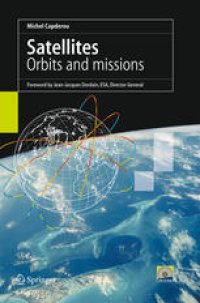
Ebook: Satellites: Orbits and Missions
Author: Michel Capderou (auth.)
- Tags: Meteorology/Climatology, Geophysics/Geodesy, Mineralogy, Oceanography, Geographical Information Systems/Cartography, Astronomy Astrophysics and Cosmology
- Year: 2005
- Publisher: Springer-Verlag Paris
- Edition: 1
- Language: English
- pdf
In all, the European Space Agency (ESA) has developed 60 spacecrafts over the last few decades. Some of these, such as the ERS satellites and Envisat, are dedicated to monitoring the Earthand providing vital data on the health status of our planet. Other spacecraft have helped to improve the accuracy of weather forecasting. Galileo, the joint ESA/EU satellite navigation p- gramme, demonstrates the political dimension of space as service-provider for the bene?t of European citizens. While these missions involve utilitarian space activities, others are devoted to either exploring the solar system, - cluding the Sun, or achieving a better understanding of the Universe and the cosmic beginnings. Theorbitsofthesesatellitescoverawiderange(Sun-synchronous,geos- tionary, highly eccentric, at Lagrange points, etc.) so that a complete novice may be astonished when tackling the space technology ?eld. The main credit of Michel Capderou’s book is to take the reader (whether it be a student, an engineer or a research scientist) progressively from the basic Kepler laws to the most complex equations of space mechanics. His educational concern has led him to propose many examples and graphicalillustrations from ESA, but alsofromthe American,Russian,Indian,Japaneseor evenChinese space agencies. These programmes provide scienti?c insights and moreover appear to fascinate the general public, in particular the younger generation. Those wishing to understand the orbital mechanisms behind these programmes will ?nd the explanations they seek in this book.
This book treats the subject of satellite orbits, showing how the wide range of available orbits can be put to use to satisfy the needs of fields as varied as communications, positioning, remote-sensing, meteorology, and astronomy. The satellite is first discussed in the context of the laws of space mechanics. The various categories of orbit (circular, elliptical, high, low, geostationary, and sun-synchronous) are then presented, together with the problem of sampling (when and how the satellite views its target). There is then a study of specific cases, in particular, applying all the ideas encountered for earth-orbiting satellites to the case of a satellite in orbit around Mars. The arguments are supported by a great many applications, figures and illustrations, with over a thousand satellites cited explicitly. The whole work is based on two pieces of software: IXION (orbitography and sampling) and ATLAS (cartography), both developed by the author himself. The book will be useful for researchers, university teachers and students working in the satellite area. School teachers, geographers, and engineers using images taken from space, as well as anyone involved in space exploration will find it a precious resource.